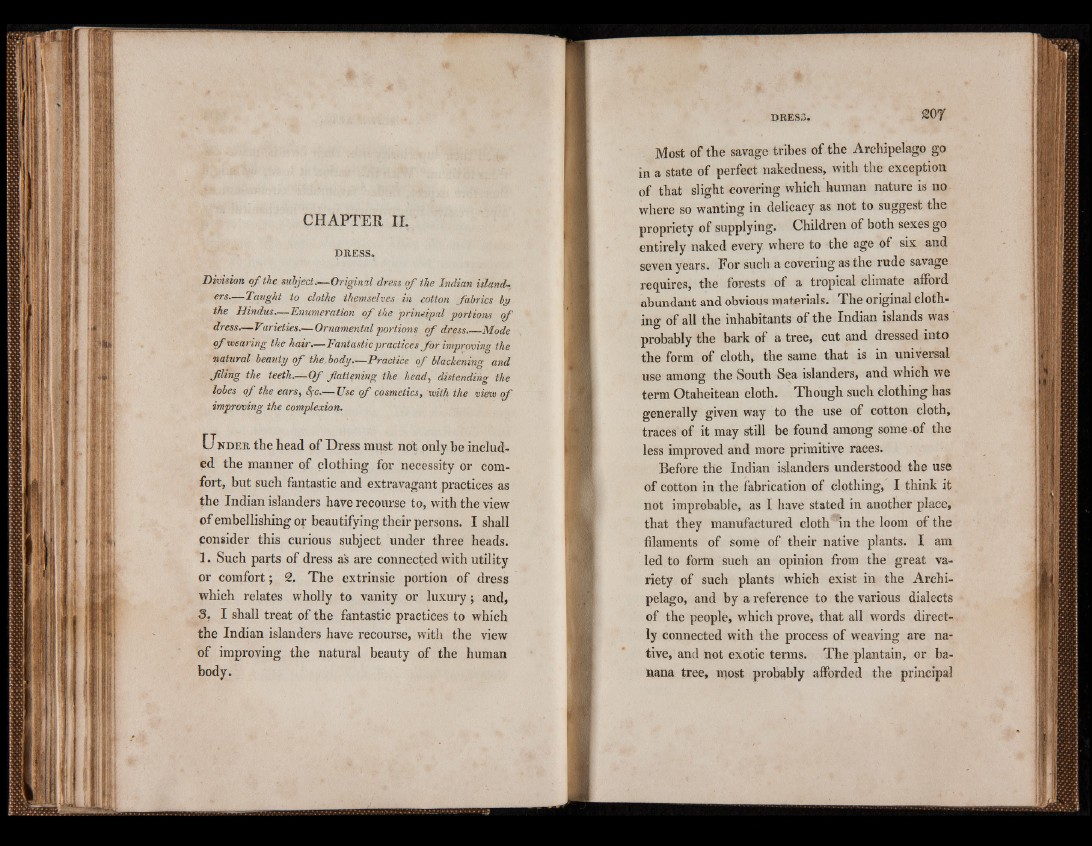
CHAPTER II.
DRESS.
Division o f the subject— Original dress o f the Indian islandL.
ers— Taught to clothe themselves in cotton fabrics by
the Hindus— Enumeration o f the principal portions o f
dress— Varieties— Ornamental portions o f dress Mode
o f wearing the hair— Fantastic practices fo r improving the
natural beauty c f the,body.— Practice o f blackening and
f l i n g the teeth.— O f flattening the head, distending the
lobes o f the ears, fyc.— Use o f cosmetics, with the view o f
improving the complexion.
U n d e r the head of Dress must not only be included
the manner of clothing for necessity or comfort,
but such fantastic and extravagant practices as
the Indian islanders have recourse to, with the view
of embellishing or beautifying their persons. I shall
consider this curious subject under three heads.
1. Such parts of dress as are connected with utility
or comfort; 2, The extrinsic portion of dress
which relates wholly to vanity or luxury; and,
3. I shall treat of the fantastic practices to which
the Indian islanders have recourse, with the view
of improving the natural beauty of the human
body.
Most of the savage tribes of the Archipelago go
in a state of perfect nakedness, with the exception
of that slight covering which human nature is no
where so wanting in delicacy as not to suggest the
propriety of supplying. Children of both sexes go
entirely naked every where to the age of six and
seven years. For such a covering as the rude savage
requires, the forests of a tropical climate afford
abundant and obvious materials. The original clothing
of all the inhabitants of the Indian islands was
probably the bark of a tree, cut and dressed into
the form of cloth, the same that is in universal
use among the South Sea islanders, and which we
term Otaheitean cloth. Though such Clothing has
generally given way to the use of cotton cloth,
traces of it may still be found among some-of the
less improved and more primitive races.
Before the Indian islanders understood the use
of cotton in the fabrication of clothing, I think it
not improbable, as I have stated in another place,
that they manufactured cloth in the loom of the
filaments of some of their native plants. I am
led to form such an opinion from the great variety
of such plants which exist in the Archipelago,
and by a reference to the various dialects
of the people, which prove, that all words directly
connected with the process of weaving are native,
and not exotic terms. The plantain, or banana
tree, most probably afforded the principal